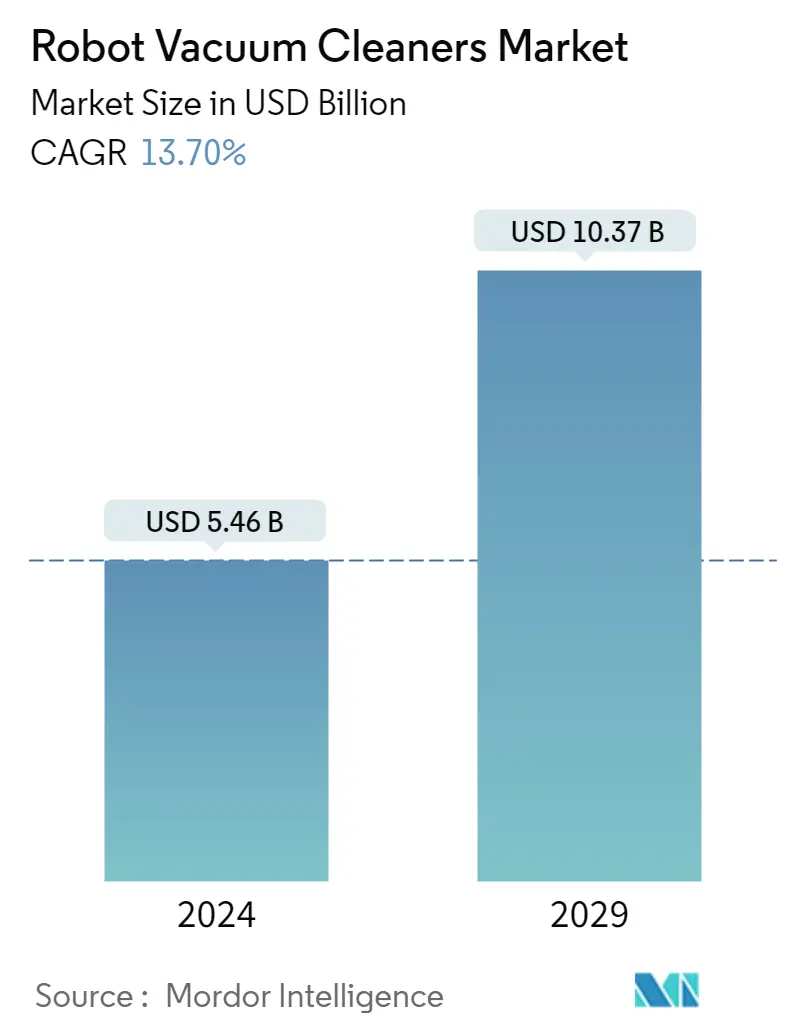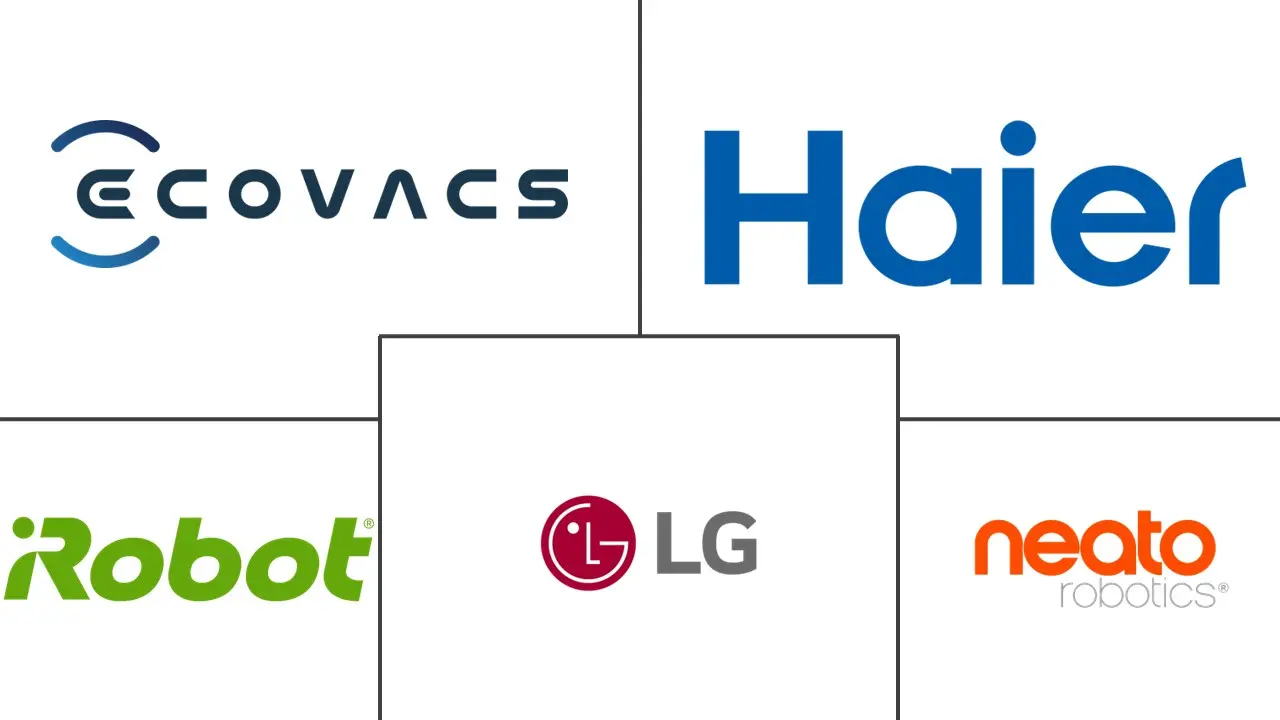Market Size of Robot Vacuum Cleaners Industry

| Study Period | 2019 - 2029 |
| Market Size (2024) | USD 5.46 Billion |
| Market Size (2029) | USD 10.37 Billion |
| CAGR (2024 - 2029) | 13.70 % |
| Fastest Growing Market | Asia Pacific |
| Largest Market | Europe |
| Market Concentration | Low |
Major Players
*Disclaimer: Major Players sorted in no particular order |
Robotic Vacuum Cleaner Market Analysis
The Robot Vacuum Cleaners Market size is estimated at USD 5.46 billion in 2024, and is expected to reach USD 10.37 billion by 2029, growing at a CAGR of 13.70% during the forecast period (2024-2029).
The growth in demand for diverse robotic applications across various industries and robotic industry improvements are two key factors motivating companies to invest in the market.
- One of the main factors influencing the growth of the robot vacuum cleaner market is the rising demand for domestic consumer robots and the increasing investment in R&D of personal service robots for aid in various household applications.
- The key driver of domestic robot adoption also includes increased customer awareness. Market players, including Future Robot, Ecovacs, Hanool Robotics, and iRobot Corporation, are investing more in R&D to provide cutting-edge domestic service robots for assistance in various household applications.
- The growing reach of Internet facilities and the widespread availability of the 5G network are factors boosting the market growth. Additionally, the global market for robotic vacuum cleaners has expanded as the culture of household chores has changed. The self-driving vacuum cleaner has also become increasingly popular.
- Consumers are more likely to purchase robotic vacuum cleaners today because of their ability to clean the area without human intervention. As these robots can automatically navigate themselves toward the charging station and restart from the same position at which it was drained, consumers don't need to bother about battery recharging. Customers can restrict admission to certain areas, such as a child's playroom, and define virtual boundaries for the robot.
- However, factors such as the expensive installation costs combined with the high cost of robot vacuum cleaner maintenance are impeding market expansion.
- In addition, people were forced to spend several weeks during the COVID-19 outbreak confined to their homes with little contact with the outside world-this increased demand for home automation in numerous nations. Consumer demand from tier-3 and beyond markets has significantly increased, making up about half of the total demand for home automation devices, while demand from metro areas has remained stable. This has also increased the demand for robot vacuum cleaners.
Robotic Vacuum Cleaner Industry Segmentation
Robotic vacuum cleaners are designed to clean autonomously without human control. North America occupies the largest market share, while Asia-Pacific is expected to be the fastest-growing market. Robots used for professional cleaning-related activities - including floor cleaning, window and wall cleaning, sewers, tank, tube, and pipe cleaning, and hull cleaning (aircraft, vehicles, ships, etc.), among others, are considered in the segment scope.
The Robot Vacuum Cleaners Market is segmented by By Type (Floor Cleaner, Pool Cleaner, Window Cleaner), End-user (Commercial, Residential), and Geography (North America (United States, and Canada), Europe (Germany, United Kingdom, France, and Rest of Europe), Asia-Pacific (China, Japan, South Korea, and Rest of Asia Pacific), and Rest of the World). The market sizes and forecasts are provided in terms of value (USD million) for all the above segments.
| By Type | |
| Floor Cleaner | |
| Pool Cleaner | |
| Window Cleaner |
| By End-user | |
| Commercial | |
| Residential |
| By Geography | ||||||
| ||||||
| ||||||
| ||||||
| Rest of the World |
Robot Vacuum Cleaners Market Size Summary
The robotic vacuum cleaner market is experiencing significant growth, driven by increasing consumer demand for domestic robots and advancements in robotic technology. Companies are heavily investing in research and development to enhance the capabilities of personal service robots, which are becoming more integrated into household applications. The proliferation of internet connectivity and the availability of 5G networks are further propelling market expansion, as these technologies enable smarter and more efficient robotic cleaning solutions. The shift in household chore culture, coupled with the convenience of self-driving vacuum cleaners, has made them a popular choice among consumers. However, high installation and maintenance costs pose challenges to market growth. The COVID-19 pandemic has also accelerated the demand for home automation, with increased interest from consumers in tier-3 markets, contributing to the rising popularity of robotic vacuum cleaners.
In North America, particularly the United States, the market for robotic vacuum cleaners is robust, supported by a high adoption rate of domestic robots and a growing inclination towards smart home technologies. The region benefits from advancements in Wi-Fi technology and the implementation of 5G, which enhance the functionality of these devices. The competitive landscape is marked by the presence of major players like iRobot Corporation and Neato Robotics, with companies focusing on product innovation, strategic partnerships, and acquisitions to maintain their market position. The introduction of advanced models with features like AI capabilities and voice assistance is expected to drive further growth. Despite geopolitical challenges affecting manufacturing, the market remains dynamic, with ongoing investments in developing more compact and integrated cleaning solutions.
Robot Vacuum Cleaners Market Size - Table of Contents
-
1. MARKET INSIGHTS
-
1.1 Market Overview
-
1.2 Industry Value Chain Analysis
-
1.3 Industry Attractiveness - Porter's Five Forces Analysis
-
1.3.1 Bargaining Power of Suppliers
-
1.3.2 Bargaining Power of Consumers
-
1.3.3 Threat of New Entrants
-
1.3.4 Intensity of Competitive Rivalry
-
1.3.5 Threat of Substitutes
-
-
1.4 Assessment of the COVID-19 Impact on the Industry
-
-
2. MARKET SEGMENTATION
-
2.1 By Type
-
2.1.1 Floor Cleaner
-
2.1.2 Pool Cleaner
-
2.1.3 Window Cleaner
-
-
2.2 By End-user
-
2.2.1 Commercial
-
2.2.2 Residential
-
-
2.3 By Geography
-
2.3.1 North America
-
2.3.1.1 United States
-
2.3.1.2 Canada
-
-
2.3.2 Europe
-
2.3.2.1 Germany
-
2.3.2.2 United Kingdom
-
2.3.2.3 France
-
2.3.2.4 Rest of Europe
-
-
2.3.3 Asia-Pacific
-
2.3.3.1 China
-
2.3.3.2 Japan
-
2.3.3.3 South Korea
-
2.3.3.4 Rest of Asia Pacific
-
-
2.3.4 Rest of the World
-
-
Robot Vacuum Cleaners Market Size FAQs
How big is the Robot Vacuum Cleaners Market?
The Robot Vacuum Cleaners Market size is expected to reach USD 5.46 billion in 2024 and grow at a CAGR of 13.70% to reach USD 10.37 billion by 2029.
What is the current Robot Vacuum Cleaners Market size?
In 2024, the Robot Vacuum Cleaners Market size is expected to reach USD 5.46 billion.

